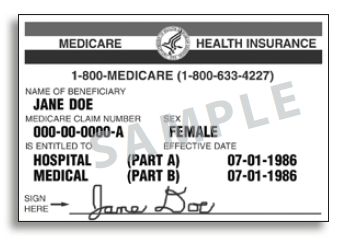
New Medicare cards to be issued – beware of scams
April 10, 2018
Medicaid 101: Part 12 – Medicaid Estate Recovery
April 19, 2018Part 10 of this blog series discussed long-term planning – that is, planning to protect assets more than five years before a Medicaid application is filed.
Many times, however, unexpected events occur and a long-term plan cannot be accomplished. Instead, a more immediate plan, called a crisis plan, could be implemented to still protect assets for a spouse or children. By implementing this type of plan, the individual can provide for his or her family members while also being able to receive the long-term care he or she needs.
Part 5 of this blog series discussed the five-year lookback period for Medicaid eligibility. If any gifts or transfers of assets are made in the five years preceding the filing of a Medicaid application, the applicant may be penalized for those gifts or transfers.
Many crisis plans involve some type of gift to a person or to a trust. If the transfer is not an exempt transfer under the Medicaid regulations (for example, to a caregiver child who meets certain requirements or to an exempt trust), the individual will be penalized for making a transfer of assets within the five-year lookback period.
Although the individual will be penalized, part of the crisis plan is to provide the individual with a way to pay for his or her care during the penalty period that will be imposed.
Gift/Annuity Plan
One crisis plan option is a gift coupled with the purchase of a Medicaid-compliant annuity. This plan can be used for either a single or a married Medicaid applicant. While the specific details of the plan vary with each situation, here is a general overview of how this crisis plan would work:
Bill and Sue have been married for 50 years. Bill is 82 and Sue is 77. They have $275,000 of countable resources. Bill unexpectedly had a stroke and was hospitalized for a week before being transferred to a nursing home. It is highly unlikely that Bill will ever be able to return home.
Sue is concerned that the cost of Bill’s care will deplete their assets. Sue is healthy and has no apparent health concerns. She would like to ensure that she can continue living comfortably, despite Bill’s sudden need for care. Moreover, she and Bill have worked hard their whole lives and are concerned with protecting some assets for their children after they both die.
Because Bill and Sue had $275,000 as of Bill’s snapshot date (see Part 6), Sue will be entitled to protect $123,600 of their resources. Bill is entitled to keep $2,000. Therefore, Sue and Bill have $149,000 in excess resources ($275,000 – $125,600).
Sue can set up an irrevocable trust and transfer about half of their excess resources ($74,700) to the trust. This transfer will cause Bill to be ineligible for Medicaid for a period of about 11.5 months (see Part 5).
To prepare for this penalty, either Sue or Bill could purchase a Medicaid-compliant annuity with the remaining excess resources. There can be pros and cons to either spouse purchasing the annuity, based on Ohio Medicaid regulations. The annuity would be an immediate pay annuity – that is, a lump sum is paid to the annuity company, and the company transforms the lump sum into a stream of monthly payments. If the annuity meets certain requirements, there is no penalty for purchasing the product, and Bill and Sue’s resources will be reduced by the annuity premium.
The term of the annuity would match the penalty period, or 11 months. By doing this, Sue and Bill have taken $74,700 of excess countable resources and turned it into a stream of income. Over the 11-month term, the annuity would pay at least $6,700 per month. This additional income can help pay for the cost of Bill’s care.
At the end of the annuity term, the penalty period will be almost over. Bill will owe a slight penalty in the 12th month. When the annuity has run out and the penalty period is over, Bill can be fully eligible for Medicaid benefits.
This plan will help Bill and Sue protect some funds for their children – the $74,700 in the trust will not be subject to recovery by the state after Bill’s death (see next week’s post regarding Medicaid Estate Recovery). The trust funds will remain in trust until both Bill and Sue have died, and their children will each receive an equal share. At the same time, Bill can receive the care he needs, and Sue will keep her spousal share of $123,600.
Annuity Only
If the individual or couple does not have a significant amount of excess resources, a trust/annuity plan may not make sense. It is possible to use the total amount of excess resources to purchase a Medicaid-compliant annuity. With an annuity-only plan, there is no penalty period. Once the annuity is purchased and the payments begin, the individual can qualify for Medicaid, assuming all eligibility requirements are met.
It is important to note that when an annuity is involved, the Medicaid applicant’s income may increase. If the applicant’s gross income exceeds $2,250 per month, he or she will need a Qualified Income Trust (see Part 4).
Pooled Trust Plan
Another crisis planning tool for single or married individuals is a pooled trust. Pooled trusts are established for disabled individuals. For purposes of creating a pooled trust, there does not need to be disability determination by the Social Security Administration, but the individual must have a physical or mental incapacity that prevents him or her from performing basic activities of daily living (bathing, grooming, toileting, dressing, eating, mobility).
Funds held in an individual’s trust account are pooled with funds of other disabled individuals for investment and management purposes. There is typically an institutional trustee and a non-profit entity serving as trust advisor.
Each individual has a separate sub-trust account. The funds in the sub-trust can be used for the individual’s supplemental needs.
When the trust is established, an advocate is named for the individual. The advocate can make distribution requests, and the non-profit entity will review the request to either approve or deny the expenditure. Most times, expenditures for food and shelter will be prohibited. However, the funds in the pooled trust can ensure the individual maintains a good quality of life. Expenditures are often made for travel and vacations, hobbies, subscriptions or newspapers, etc.
The terms of the pooled trust must require that at the individual’s death, any balance remaining in the trust will be paid to the State of Ohio for medical expenses paid on the individual’s behalf. Thus, the primary goal of a pooled trust is not to protect assets for the family, but to allow the individual to maintain his or her lifestyle, despite the need for long-term care.
There are three pooled trust companies in Ohio: Community Fund Management Foundation, The Disability Foundation, and Nonprofit Pooled Trust.
Do Nothing Option
Not every situation lends itself to crisis planning. Sometimes, the types of assets or specific situation may not allow for planning that makes sense. For example, if large amounts of assets are held in an IRA or other tax-deferred account, the crisis planning options may require those accounts to be liquidated and the individual to pay income taxes as a result.
Additionally, if the individual cannot create a plan for himself or herself, there must be a financial power of attorney with sufficient authority granted to the agent to implement the plan on the individual’s behalf. In many crisis situations, there may not be a strong power of attorney. See Part 10 for discussion about creating a strong power of attorney in advance.
An individual or couple may not want to protect assets or use the funds for anything except their own care. Just because there are options available does not mean a plan should be created if it goes against the individual’s or couple’s goals.
Additional Notes
In crisis situations, timing is essential. It is important to seek legal advice sooner rather than later. Crisis planning requires careful consideration of the situation from various angles, so be sure to work with an attorney who understands the regulations and Medicaid application process to ensure the individual’s care is not jeopardized.


